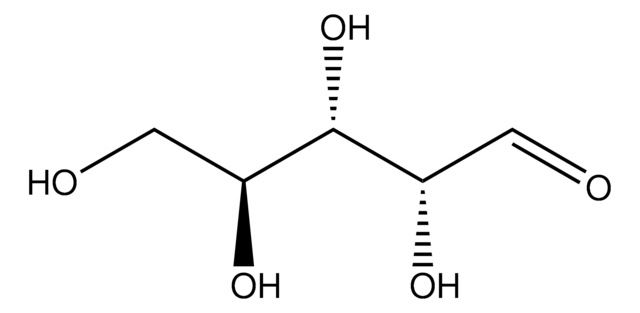G0750
D-(+)-Galactose
≥99% (HPLC)
Sinônimo(s):
Galactose
About This Item
Produtos recomendados
fonte biológica
bovine (Ruminant- Cow, Ox, Buffalo)
Nível de qualidade
Ensaio
≥99% (HPLC)
forma
powder
técnica(s)
HPLC: suitable
Impurezas
≤0.1% glucose
cor
white
faixa de pH útil
5.0-7 (25 °C, 180 g/L)
pf
168-170 °C (lit.)
solubilidade
H2O: soluble 100 mg/mL, clear, colorless
temperatura de armazenamento
room temp
cadeia de caracteres SMILES
OC[C@@H](O)[C@H](O)[C@H](O)[C@@H](O)C=O
InChI
1S/C6H12O6/c7-1-3(9)5(11)6(12)4(10)2-8/h1,3-6,8-12H,2H2/t3-,4+,5+,6-/m0/s1
chave InChI
GZCGUPFRVQAUEE-KCDKBNATSA-N
Procurando produtos similares? Visita Guia de comparação de produtos
Aplicação
- as a component of galactosyltransferase labeling buffer.
- as a supplement in MRS broth for the growth of thermophilic lactobacilli
- to induce the expression of uncoupling protein (UCP) in yeast transformants
Ações bioquímicas/fisiológicas
Outras notas
Código de classe de armazenamento
11 - Combustible Solids
Classe de risco de água (WGK)
WGK 3
Ponto de fulgor (°F)
Not applicable
Ponto de fulgor (°C)
Not applicable
Equipamento de proteção individual
Eyeshields, Gloves, type N95 (US)
Escolha uma das versões mais recentes:
Já possui este produto?
Encontre a documentação dos produtos que você adquiriu recentemente na biblioteca de documentos.
Os clientes também visualizaram
Nossa equipe de cientistas tem experiência em todas as áreas de pesquisa, incluindo Life Sciences, ciência de materiais, síntese química, cromatografia, química analítica e muitas outras.
Entre em contato com a assistência técnica





